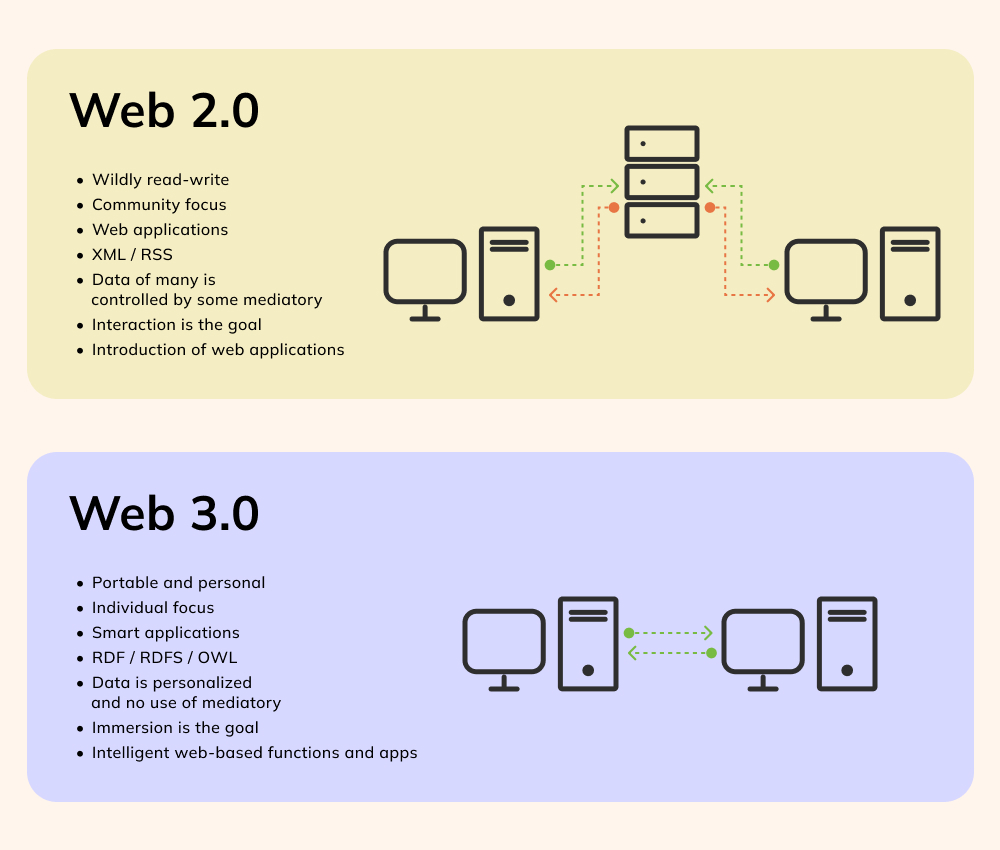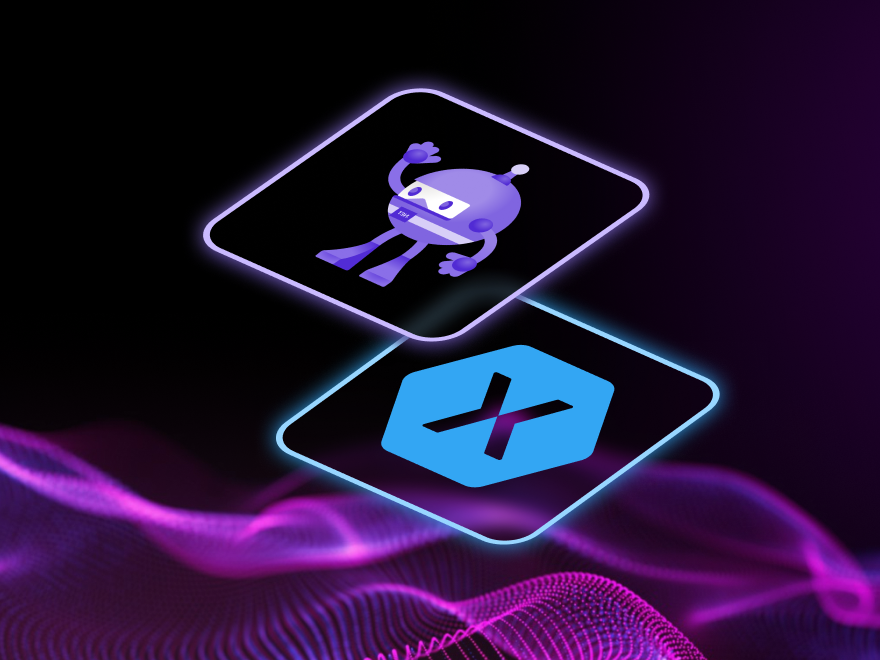Your message has been sent.
We’ll process your request and contact you back as soon as possible.
The form has been successfully submitted.
Please find further information in your mailbox.



Also known as Web3, Web 3.0 functions on a decentralized platform while the entire information is processed smarter, more human-like. The basis of this executive web is formed with the combination of machine learning, artificial intelligence, semantic web, and blockchain contrasted to such basic techs of Web 2.0 as Javascript, AJAX, mobile computing, and Cloud. In particular, such a powerful core ensures even greater transparency and higher speed of experience for users.
Initially, Web 3.0 was addressed as the Semantic Web by Tim Berners-Lee (the creator of the World Wide Web) and was intended to build the next generation of the internet, which would be more intelligent and autonomous than the preceding version.
However, Web 3.0 aims to return control over the data to internet users. What does this mean? It means that from now on, users will be able to govern their data and not just exchange it like they did in the past. For instance, if users sell their data to advertisers, they still retain ownership and the right to data privacy.


Decentralization helps unlock new growth opportunities.
Embrace Web 3.0 and step into the future of business.
The core properties supporting the entire Web 3.0 Metaverse include connectivity, decentralization, 3D graphics, the semantic web, artificial intelligence, a permissionless environment, and machine learning.
Nevertheless, another key feature distinguishing Web 3.0 is its trustless nature. The end user can interact directly without an intermediary’s services. Generally, no one is obliged to get authorized by a governing body to participate. As a result, Web 3.0 apps are predisposed to run on decentralized networks or blockchains.
With Web 3.0, users get the power to control previously centralized products. For example, you can tokenize anything literally, from an ordinary ticket to a sports match to an expensive piece of art.
Web 3.0 examples are numerous, just as the spheres that will benefit from it. However, gaming is one of the best sectors that clearly benefits consumers of Web 3.0. Now gamers will get the chance “to buy” control over the game after investing. This control will be expressed through voting on how the games should process, what changes should be applied, what features should be upgraded in the next updates, etc.

The Metaverse, an immersive 3D virtual world that allows users to interact in real-time, is another much talked-over technology of the decade, along with Web 3.0. Since both refer to the future of the internet and the social realm, many people confuse these two concepts. To have a better understanding of what users should anticipate, let’s first highlight their key differences and similarities. It will also help us understand whether businesses should invest in Web 3.0 or not.
Web 3.0 is a digital space where users can create content, share it, and designate deals. All interactions and data transfers will be decentralized, and the authenticity is confirmed by the blockchain. In addition, it enhances data arrangement and structurization on the net so that the data becomes widely available for all internet users worldwide.
Meanwhile, Metaverse is the virtual sphere of the future you should enter. It sort of connects online and offline worlds based on virtual and augmented reality. When users enter Metaverse, they are provided with a wide variety of entertainment options as well as initiatives that span the whole augmented reality landscape. In addition, the Metaverse allows users to meet, play, work, and socialize in 3D spaces. Obviously, finances will be managed through cryptocurrency.
Since Metaverse will be driven by augmented reality, every user will control an avatar or character, just like in most modern video games today. By the way, nowadays, video games provide the closest Metaverse experience of all available offers.
However, what connects Web 3.0 and Metaverse is that both concepts focus on the next generation of internet technology by changing how data and goods are transferred on the net.

Web 3.0 is undoubtedly gaining traction among investors and institutions. So now is the time to start considering how to invest in the new generation of internet. As you can see, Web 3.0 is definitely worth investing in, and the matter of the investment spheres is already more sensible.
To get the right answer to this question, you should have a basic understanding of what Web 3.0 aspects will most satisfy your interests and be appropriate for investments.
For instance, one of the worthwhile investment forms in Web 3.0 is the blockchain itself. It will provide the following parameters for Web 3.0.
Web 3.0 crypto tokens are increasingly capturing investors’ interest. Cryptocurrency is expected to play a key role in selling and buying products or services on Web 3.0, as well as in gaming and investing. With all this in mind, cryptocurrencies can become an excellent investment within Web 3.0.
Web 3.0 is expected to integrate such cryptos as ETH, Helium, Theta, Polkadot, Filecoin, Kasuma, etc.
The Recycle Bin, Cryptopunks, and other super popular NFTs make only a tiny part of what an NFT can actually signify. Firstly, these tokens can be used as a currency form to pay content creators. Secondly, like vaccine passports, NFTs can serve as document verification since they include historical ownership data.
Furthermore, you can invest and use NFTs in logistics to inform customers about how long it takes to produce and deliver goods. Generally, these tokens can give you much potential – they are viable investment options for the future generation internet Web 3.0.
Domains in Web 3.0 will most certainly differ from the standard DNS addresses. Although those will be multiple-character hex strings, users can simply remember a shorter phrase. For example, a decentralized crypto domain will be a human-readable address indicating not the IP address but the user’s crypto wallet. These domains are NFTs or digital certificates of validity by their nature and have Web 3.0 extensions as .eth, .dao, and .crypto.
So, right now, it is high time to buy a selection of potentially lucrative domain names to sell them for a profit when the time comes. The limited supply vs. growing demand and the big return on your investment help domain names play a special role in Web 3.0
Our specialists have rich expertise, which enables them to keep up with all the most cutting-edge technologies. Today, we work to actualize the entire Web 3 ecosystem by expanding our understanding of various Web 3 technologies and how to incorporate them into blockchain.
No matter your background, we’ll support you in accomplishing your goals. Our business has provided considerable technical assistance to companies creating software solutions in the fields of blockchain, AI/ML, VR/AR, and other WEB3-related technologies since 2007. We have developed a variety of Web 3 and blockchain-based applications for clients all over the world. With our help, you can launch WEB 3 solutions in any business domain and get the best results. Contact us today and get a free project cost estimate.
Rate this article:
4.8/5 (45 reviews)












Your message has been sent.
We’ll process your request and contact you back as soon as possible.

By signing up you agree to our Privacy Policy, including the use of cookies and transfer of your personal information.